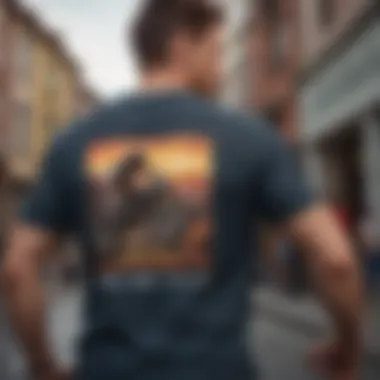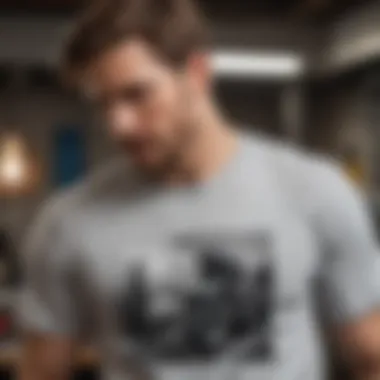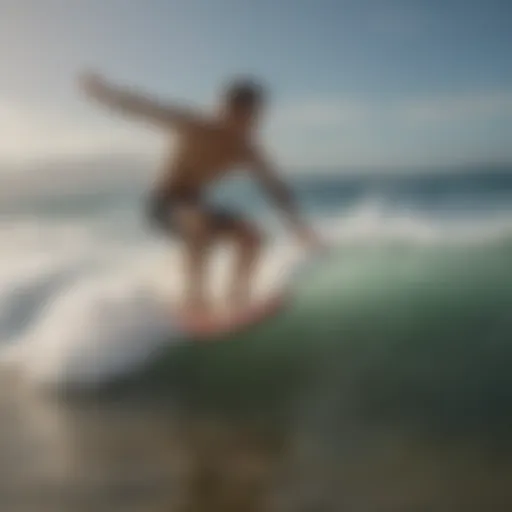Mastering T-Shirt Art for Extreme Sports Fans


Intro
Drawing on t-shirts is a practice deeply woven into the fabric of extreme sports culture. It serves not only as a medium for individual expression but also as a significant marker of identity among athletes and fans alike. When engaged in activities like skateboarding, snowboarding, or surfing, a custom t-shirt can bridge the gap between personal passion and public image. This article aims to explore various aspects of these artistic endeavors, examining the tools, techniques, and ethos behind making impactful designs that resonate within the extreme sports community.
Understanding the nuances of drawing on t-shirts creates an opportunity to connect more profoundly with the extreme sports lifestyle. Creating artwork for personal apparel goes beyond aesthetics; it becomes a form of personal branding, a canvas for storytelling. Throughout this guide, we will cover essential techniques and tips, explore the necessary gear and equipment, discuss safety measures, and shine a light on different extreme sports. By the end, the reader will gain a comprehensive insight into effectively integrating art with extreme sports enthusiasm.
Foreword to T-Shirt Art
T-shirt art is more than just a method of personal expression; it is a canvas for creativity and identity. This section aims to highlight why t-shirt art is pivotal, particularly within niche communities, such as extreme sports enthusiasts. Creating art on t-shirts serves as a medium through which individuals channel their passions, beliefs, and influences. From custom designs that symbolize personal victories to graphics that represent community events, t-shirt art has become an integral part of the culture.
When skills in t-shirt drawing are harnessed adeptly, artists can create pieces that resonate with a broader audience. Such artworks foster connection among likeminded thrill-seekers, transforming simple clothing into wearable statements. These designs also allow for unique branding opportunities. Individuals can establish their identity in the extreme sports landscape, signaling their activities and allegiances to the world around them.
In the subsequent subsections, we will explore the cultural significance behind t-shirt art and its relevance to extreme sports. Understanding these elements is crucial for any artist eager to connect with their audience authentically through their designs.
Cultural Significance of T-Shirt Art
T-shirts have evolved into a powerful cultural symbol over the decades. They carry messages, provoke thoughts, and can even challenge societal norms. The ease of production and dissemination makes t-shirts an accessible medium for artists and advocates alike. In many cultures, t-shirt art serves as a visual diary, documenting the movements, events, and ideologies that shape our world today.
For artists in the extreme sports community, t-shirt designs are not simply about aesthetics; they often reflect the struggles, triumphs, and identities of the athletes. These designs can commemorate significant sporting events, echo the spirit of adventure, or spotlight environmental causes relevant to outdoor sports. As such, t-shirt art becomes an expression of shared values, aspirations, and experiences.
Relevance to Extreme Sports
In the realm of extreme sports, t-shirt art plays a uniquely vital role. Extreme sports, such as skateboarding, snowboarding, or motocross, thrive on individuality and self-expression. Athletes often seek to differentiate themselves, not only through their skills but also through their style. A well-designed t-shirt can communicate an athlete's personality, beliefs, and even their personal brand.
Additionally, t-shirts serve as a form of memorabilia for competitions or gatherings within extreme sports circles. They can embody a shared sense of community, referencing specific events, teams, or challenges that resonate within their respective sports. The art on these t-shirts can also act as a conversation starter, bridging gaps between athletes and fans alike.
Recognizing the importance of t-shirt art opens doors for extreme sports enthusiasts to not only express themselves but also connect with others who share their passion. Embracing this art form can redefine personal branding and foster a unique sense of belonging within the extreme sports community.
Understanding the Basics of T-Shirt Drawing
Understanding the basics of t-shirt drawing is essential for anyone who wants to master this art form, especially within the extreme sports culture. It provides the foundation for expressing one’s individuality through wearable art. Basics include knowledge of materials, fabric types, and essential techniques, which can greatly influence the end result.
Starting with the right considerations is crucial. For instance, selecting suitable fabrics ensures that your designs not only look good but also withstand the rigors of extreme activities. Different materials respond uniquely to various inks and paints, impacting both the feel and longevity of the artwork. Thus, knowing about these factors enhances the creator's ability to produce high-quality designs that cater to the wearer's lifestyle.
Moreover, understanding drawing techniques adds depth to one's skill set. It helps in translating ideas into compelling visuals. A well-rounded grasp of techniques allows for creativity to flourish, resulting in designs that resonate with the wearer’s personality and interests.
In essence, mastering the basics in t-shirt drawing opens doors to unique artistic expression. It enables extreme sports enthusiasts to wear their passion boldly, showcasing their identity and beliefs through their apparel.
Types of T-Shirt Fabrics
Choosing the right fabric is paramount for anyone looking to draw on t-shirts. The following fabric types are commonly used:
- Cotton: This natural fiber is breathable and comfortable, popular among t-shirt lovers. It takes ink well but can shrink after washing.
- Polyester: Synthetic and durable, this fabric resists wrinkles and is great for vibrant colors. However, it may feel less breathable than cotton.
- Blends: Combinations of cotton and polyester offer a balance of comfort and durability. They are often used for sportswear because they provide breathability and fend off moisture.
When selecting fabric, consider intended use. For extreme sports, durability and flexibility may take priority. Always test how your chosen inks or paints interact with the fabric to ensure a successful design.
Essential Drawing Techniques
Effective t-shirt drawing hinges on mastering a few key techniques. Here are some fundamentals:
- Sketching: Begin with pencil sketches to visualize ideas. This allows easy adjustments before moving to permanent inks.
- Stenciling: This technique involves creating a cut-out template that can be painted over. It's helpful for consistent designs, especially logos.
- Freehand Drawing: While more challenging, this technique offers greater artistic freedom. It allows for unique, one-of-a-kind designs.
- Fabric Painting: Use paints specifically designed for fabric to ensure adhesion and longevity. Techniques like brushwork or sponge application can yield different textures and effects.
Focusing on these drawing techniques helps in creating designs that stand out and remain intact despite wear and tear. Becoming proficient in these basics will ultimately enhance your work and attract the attention of fellow extreme sports enthusiasts.
Tools and Materials for Drawing on T-Shirts
Drawing on t-shirts combines creativity with technical skill. To achieve a successful design, it is crucial to select the right tools and materials. This section will explore various elements integral to t-shirt art, focusing on advantages, considerations, and essential components.
Choosing the Right Inks and Paints
Inks and paints are fundamental to t-shirt design. Different media produce varying results in texture and durability. Fabric paint is popular for its adherence and flexibility on textile surfaces. When selecting inks, consider the fabric type and intended use.
- Fabric Paints: These are specifically designed for t-shirt application. They come in various forms and finishes like matte, glossy, and metallic. Fabric paints maintain the breathability of the shirts while being durable.
- Acrylic Inks: These offer a vibrant finish and are versatile. However, ensure they are mixed with a medium suitable for fabric applications to avoid cracking.
- Screen Printing Inks: If you are looking into larger production runs, screen printing inks provide consistent results but may require additional setup.


Always test inks on a scrap piece of fabric before applying them to your final design. This ensures that the colors and texture meet your expectations.
Recommended Drawing Tools
The right tools can make a meaningful difference in the drawing process. Here are some essential items for creating your designs.
- Brushes: Variety in brush sizes aids in different strokes and detail work. Flat brushes are effective for large areas, while fine-tipped brushes allow for precision.
- Dyes and Markers: Fabric markers can be beneficial for quick designs. They offer control for fine details and smaller projects. Ensure they are labeled as suitable for fabric.
- Stencils: If precision is key, stencils help maintain uniformity in designs. These can be particularly useful for recurring themes or patterns.
- Pencils and Charcoal: For sketching ideas initially on fabric, use fabric pencils or charcoal. These help in outlining your design before painting.
- Heat Gun or Iron: Using a heat source is often necessary to set the paint, ensuring it adheres properly to the fabric. Following the manufacturer's instructions for heat-setting is critical.
Each tool has its purpose, and understanding how they work together can enhance your creative process.
"The tools you choose can either limit or expand your creative possibilities. Make informed choices to express your style effectively."
Investing time in selecting the appropriate materials and tools lays the groundwork for crafting t-shirt designs that resonate with extreme sports enthusiasts.
Techniques for Effective T-Shirt Design
In the world of t-shirt design, especially within extreme sports, effective techniques can mean the difference between a mediocre product and a standout piece that captures attention. Understanding various design techniques allows artists and enthusiasts to express their unique identities and resonate with their audience. Effective designs are not just visually appealing; they also tell a story, convey a message, or evoke a feeling. When specialized for extreme sports, these designs reflect the adrenaline, energy, and passion associated with the activities.
Line Work and Detailing
Line work is foundational in t-shirt design. Whether it’s bold strokes or intricate patterns, it sets the overall feel of the design. Strong lines can suggest movement or speed, which are pertinent in extreme sports. Details in line work can also add depth to the design. Fine lines can create textures, while thicker lines can emphasize important aspects. Some considerations include:
- Clarity: Ensure lines are clean and recognizable. Complicated line work can be confusing.
- Balance: Mix heavy and light lines to add interest.
- Coordination with Theme: Align the line style with the sport’s character, such as sharp angles for skateboarding or flowing lines for surfing.
Using the right tools, like fineline pens or brushes, will enhance your line work. Focus remains on making the design cohesive and expressive.
Color Theory in T-Shirt Design
Color is a powerful tool in design, influencing feelings and perceptions. When creating t-shirt art for extreme sports, consider how colors reflect the spirit of the sport and the audience it attracts. Different colors can evoke different emotions, and understanding color theory helps in making strategic choices. Here are several key elements to think about:
- Color Wheel: Familiarize yourself with complementary and analogous colors. Complementary colors can create striking contrasts. Meanwhile, analogous shades create harmony, appealing in certain contexts.
- Psychology of Colors: Red can signify excitement or danger, which resonates with extreme sports. Blue can connote calmness or freedom. Choose colors that align with the message.
- Contrast and Visibility: Ensure colors contrast against the fabric color. This increases visibility while wearing, crucial for extreme sports enthusiasts.
Using color thoughtfully can elevate a design from ordinary to extraordinary.
Incorporating Text and Typography
Text is often an integral component of t-shirt designs, especially in extreme sports, where slogans or athlete names can transform a simple design into something more personal. Typography must be carefully considered to ensure the text integrates well with the overall visual style. Important aspects include:
- Font Selection: Choose fonts that reflect the character of the sport. For example, a bold, chunky typeface may work well for snowboarding apparel, while a sleek, modern font suits activities like BMX biking.
- Text Placement: Consider where text is placed within the design. It should complement visuals without overcrowding them. Proper placement creates flow and readability.
- Message Clarity: Ensure the text conveys a clear message. This can be motivational, humorous, or straightforward, but it must align with the extreme sports culture.
Combining striking imagery with impactful typography creates eye-catching designs that stand out in the competitive world of extreme sports apparel.
"Effective t-shirt design captures the essence of the sport and the personality of the wearer, making it a canvas for self-expression."
By mastering these techniques, artists and enthusiasts can significantly enhance their t-shirt designs, creating pieces that resonate with the extreme sports community while showcasing their artistic capability. Understanding how to balance line work, color, and typography is fundamental in making a mark in the world of custom apparel.
The Process of Drawing on T-Shirts
Understanding the process of drawing on t-shirts is crucial for enthusiasts who desire to blend creativity with practical application. This section highlights the steps involved, emphasizing the balance between artistic vision and technique. A structured approach facilitates not only the quality of the design but also ensures that the end product is something that the creator and the wearer can take pride in.
The importance of this process cannot be overstated: it helps in the production of durable, visually appealing designs that resonate with the spirit of extreme sports.
Preparing the Workspace
Creating a functional workspace is the first step in the drawing process. A well-arranged workspace can significantly influence the creativity and efficiency of the artist. Consider these key elements when setting up:
- Cleanliness: Ensure your area is free from clutter to prevent distractions.
- Lighting: Good lighting is essential. Natural light or bright LED bulbs can aid in accurately discerning colors.
- Tools Accessibility: Organize all required materials within reach to streamline your workflow.
- Comfort: A comfortable chair and a stable table will enhance your focus and endurance during the drawing process.
Preparing a workspace not only makes working easier but helps in maintaining a level of professionalism and dedication to the craft.
Sketching the Design
Sketching is where ideas take form. It allows for experimentation with shapes, layouts, and themes. Several considerations play a role in this phase:
- Pilot Concepts: Begin with rough drafts to explore various ideas. Don’t hesitate to iterate.
- Proportions and Layouts: Pay attention to the size of your design in relation to the t-shirt. A sketch that occupies the perfect amount of space adds to overall visual impact.
- Style Consistency: Choose a style that reflects both personal and extreme sports identity. This could range from bold street art designs to minimalist graphics.
Ultimately, the sketch serves as a blueprint for the final design. Spending adequate time in this stage ensures a smoother transition to the finalizing process.
Finalizing the Artwork
The finalization of the artwork is where the concept comes to life. This includes refinement and preparation for application. Key steps in this phase are:


- Detail Enhancement: Carefully add details in line work or color application, ensuring clarity and vibrancy.
- Color Application: Test colors on scrap fabric to see which combinations work best. Color selection is critical for aesthetic appeal in extreme sports settings.
- Quality Check: Before applying the final design, review the sketch for any last adjustments. A critical eye can catch errors that might have been overlooked initially.
- Transfer Preparation: If using stencils or transfers, ensure they are correctly aligned to match the desired placement on the t-shirt.
The artistry involved in drawing on t-shirts is a rewarding endeavor, especially for those in the extreme sports community looking to make a personal statement. The detailed steps outlined in this section create a pathway for artists to articulate their vision in a tangible format.
Exploring Different Styles of T-Shirt Art
The realm of t-shirt art is both varied and dynamic. For those involved in extreme sports, this art form serves not only as a medium of self-expression but also a reflection of personal identity. Exploring different styles of t-shirt art allows enthusiasts to tap into trends, culture, and their own creativity. This section aims to cover the significance of these styles and how they infuse life into the world of extreme sports.
Street Art Influence
Street art plays a pivotal role in shaping t-shirt designs for the extreme sports community. Artists often draw inspiration from urban landscapes, conveying messages that resonate with younger audiences. The infusion of bold colors and distinct patterns mirrors the vibrancy of street culture.
Street art’s connection to extreme sports lies in its rebellious spirit. Many extreme sports, from skateboarding to BMX riding, thrive on a culture of defiance against traditional norms. This is echoed in the artwork, which frequently challenges societal expectations and highlights a sense of freedom.
Key elements of street art in t-shirt design include:
- Graffiti-style fonts: These fonts embody an informal, energetic essence that relates directly to the lifestyle of extreme sports enthusiasts.
- Dynamic imagery: The graphics often depict motion, action, or thrilling scenes that capture the adrenaline rush associated with extreme sports.
- Collaboration with local artists: By working with street artists, brands can create unique, limited-edition designs that not only appeal to customers but also elevate the cultural significance of the work.
This influence does not just elevate the aesthetic of t-shirts; it also creates a community around the designs. Wearers often feel a connection to the street art movement and to one another, cultivating a sense of belonging within the extreme sports culture.
Graphic and Minimalist Approaches
In contrast to the boldness of street art, graphic and minimalist approaches offer a refined take on t-shirt design. These styles emphasize simplicity and clarity, allowing the essence of the message to shine through without unnecessary distractions. For extreme sports enthusiasts, this can result in designs that are modern and impactful.
Graphic design often incorporates clean lines, geometric shapes, and thoughtful placements of images and text. The use of negative space in minimalism promotes a clean aesthetic that can appeal to a wide audience without diluting the message.
Considerations for graphic and minimalist t-shirt designs might include:
- Clear visual hierarchy: Essential elements of the design should stand out, guiding the viewer’s eye to the most important parts of the artwork.
- Eco-conscious themes: Many minimalist designs utilize sustainable practices and materials, aligning with the growing value placed on environmental responsibility among extreme sports fans.
- Focus on brand identity: The simplicity of a well-executed design often strengthens brand recognition, making it easier for the audience to connect with the ethos of the sport or activity.
Both graphic and minimalist styles present opportunities for innovation. They challenge artists to think critically about what is essential in their designs while appealing to a demographic that appreciates both subtlety and sophistication.
In summary, the exploration of different styles in t-shirt art enhances the connection between culture and craft. Street art brings vibrancy and rebellion, while graphic and minimalist approaches provide clarity and sophistication. Each style enriches the artistic landscape, allowing extreme sports enthusiasts to express their identities meaningfully.
Sustainability in T-Shirt Drawing
Sustainability in t-shirt drawing is an essential aspect that every artist and enthusiast should consider. The increasing awareness of environmental issues makes it important for individuals to think about the impact of their choices, especially in the fashion industry. Drawing on t-shirts can be an avenue for personal expression, but it should not come at the cost of harming the planet. By focusing on sustainable practices, artists can contribute to the global effort to reduce waste and support eco-friendly initiatives.
When discussing sustainability, one must consider eco-friendly materials and responsible design practices. Choosing the right materials and methods not only benefits the environment but also enhances the overall quality of the artwork.
Eco-Friendly Materials
The term 'eco-friendly materials' refers to substances that are safe for the environment and reduce negative impacts. In the context of t-shirt art, this includes organic cotton, recycled polyester, and water-based inks. Using organic cotton ensures that the fabric is cultivated without harmful pesticides, saving the earth from toxic chemicals.
Additionally, many brands now offer inks that are produced from natural ingredients, which have minimal environmental consequences. Switching to these materials may require an initial investment, but the long-term benefits far outweigh the costs. By using materials that are biodegradable and recyclable, artists can ensure their creations do not end up polluting landfills.
Examples of eco-friendly inks include:
- Water-based inks: Easy to work with and non-toxic.
- Soy-based inks: Derived from natural sources.
- Plant-based dyes: Provide vibrant colors without harmful chemicals.
Responsible Design Practices
Responsible design practices encompass a range of strategies aimed at minimizing waste and promoting sustainability in t-shirt drawing. One key element is prioritizing quality over quantity. Rather than producing numerous t-shirts that may end up unused, creating fewer high-quality designs can fly higher in value and appeal, thus encouraging buyers to invest in quality pieces.
Moreover, artists should consider digital design methods, which allow for testing and adjustments before actual production. This reduces material waste by eliminating errors associated with traditional methods.
Here are some points to consider for responsible design:
- Utilize local resources: Sourcing materials locally reduces carbon footprint.
- Minimize waste: Use scraps and remnants creatively to make new products.
- Educate: Share knowledge about sustainable practices with the community.
"Sustainability is not just a trend; it is a responsibility towards the planet and future generations."
Promoting Your T-Shirt Art in Extreme Sports Communities
Promoting your t-shirt art within extreme sports communities is a vital step for creators seeking to make their mark in this unique niche. This process not only showcases individual creativity but also establishes connections within the community, allowing artists and enthusiasts to bond over shared interests. Effective promotion can lead to increased visibility and recognition, which is particularly important for artists looking to build a brand. Visibility can also translate into sales, as well as opportunities for collaboration and networking.


Understanding the nuances of this audience is key. Extreme sports enthusiasts are often passionate about authenticity and expression. They appreciate designs that resonate with their experiences and lifestyles. Therefore, following specific strategies tailored to this demographic can enhance the success of your art promotion efforts.
Social Media Strategies
Social media platforms are crucial in promoting t-shirt art because they offer a wide-reaching and cost-effective medium for communication. Many extreme sports enthusiasts actively engage on platforms such as Instagram, Facebook, and Reddit. Here are a few effective strategies:
- Utilize Hashtags: Use relevant hashtags to reach a broader audience. Hashtags like #ExtremeSports, #TshirtArt, and #CustomApparel can help in connecting with individuals interested in these areas.
- Share Progress Updates: Posting behind-the-scenes content and progress shots of your designs can create engagement. Users appreciate seeing the creative process and may feel more inclined to support your work.
- Engage with the Community: Respond to comments, share user-generated content, and engage in discussions. Being an active participant can elevate your visibility and credibility.
- Host Contests or Giveaways: Encourage sharing by organizing contests where participants can win a custom t-shirt. This tactic can spread the word about your art and motivate friends to engage with your work.
Building a loyal following on social media is essential for a successful promotional strategy. It helps in creating a brand identity that resonates with extreme sports enthusiasts.
Collaborations with Athletes and Influencers
Collaboration with athletes and influencers can significantly amplify the reach of your t-shirt art. These individuals have established followings and can introduce your designs to a broader audience. Here are some considerations for effective partnerships:
- Identify the Right Influencer: Look for athletes who align with your brand and aesthetic. Their personal style should resonate with the type of designs you create. This alignment ensures authenticity in the promotion.
- Develop Unique Collaborations: Create exclusive designs or limited-edition t-shirts together. This can create buzz and drive urgency for purchase.
- Leverage Their Platforms: Ask your collaborators to showcase the designs on their social media. Their endorsement can lend credibility and attract their audience’s interest.
- Participate in Events Together: Engage in related events or competitions where you can showcase your work alongside your collaborators. This is an opportunity not just to sell but also to display the artistry behind the design.
In essence, promoting your t-shirt art in extreme sports communities requires a strategic and authentic approach. By leveraging the platforms available, you can bridge the gap between your creativity and the audience that craves unique expressions through apparel.
The Future of T-Shirt Art in Extreme Sports
The future of t-shirt art in extreme sports indicates not just a continuation but an evolution of how athletes and enthusiasts express their identities and communities. Custom t-shirts have long served as a canvas for personal statements, but upcoming changes suggest a richer tapestry of design, technology, and social consciousness. This segment delves into emerging trends, innovations, and the challenges that may redefine this artistic domain.
Emerging Trends and Innovations
In the world of extreme sports, several trends point to where t-shirt art is headed. First, digital printing technology has advanced significantly. It allows for intricate designs that were not possible with traditional methods. Athletes can now replicate detailed artwork with precision, bringing a new level of creativity to their apparel. Using software to create designs also speeds up the process, making it more accessible for both amateurs and professionals.
Another noteworthy trend is the rise of sustainable inks and fabrics. With increasing environmental awareness, many artists and companies are investing in eco-friendly materials. Organic cotton and water-based inks minimize the ecological footprint of t-shirt production. By embracing these sustainable practices, designers can also communicate their values to their customers, aligning themselves with the values that extreme sports often embody.
In addition, social media platforms facilitate a faster exchange of ideas and inspirations among creators. As enthusiasts document their sports journeys, they often showcase their custom t-shirts, enhancing visibility for independent artists. This sharing fosters a community where creativity flourishes and drives new trends.
- Key emerging trends in t-shirt art for extreme sports:
- Adoption of digital printing for detailed designs
- Use of sustainable inks and fabrics
- Enhanced visibility through social media interactions
Potential Challenges Ahead
While the future looks promising, several challenges loom in the realm of t-shirt art in extreme sports. Market saturation is one concern. As more individuals begin creating custom apparel, standing out becomes crucial but increasingly difficult. Unique designs can get lost in a sea of similar offerings, making it imperative for artists to innovate continually and find ways to differentiate their work.
Moreover, the demand for quality over quantity places pressure on artists. Not only must they create distinct designs, but they also have to ensure that their t-shirts maintain durability and comfort through rigorous activities. This can involve selecting the right fabrics and ensuring that the printing method withstands wear and tear under extreme conditions.
Lastly, as technology evolves, so does the risk of copyright infringement. Many artists are concerned that their original works could easily be copied or misused. Establishing a clear path for ownership and rights in an ever-changing digital landscape is vital to protect creators and maintain the integrity of their designs.
- Challenges faced by artists in the future:
- Market saturation with numerous custom designs
- Balancing quality and unique expressions
- Copyright issues arising from digital sharing
In summary, the future of t-shirt art in extreme sports presents exciting opportunities intertwined with significant challenges. For creators, adapting to ever-changing consumer expectations and industry standards is essential to ensure their art not only survives but thrives.
Finale
The conclusion of this guide draws together the various elements discussed throughout the article. The importance of custom t-shirt art within extreme sports culture cannot be overstated. It serves as a canvas for personal expression, allowing individuals to showcase their unique identity and passion for their chosen activities. By understanding the techniques, tools, and sustainability practices detailed in earlier sections, artists can create designs that resonate personally while also appealing to the broader community.
Incorporating sustainable practices is not just a trend but a responsibility. Extreme sports enthusiasts often spend significant time outdoors. Thus, the materials they choose reflect not only their personal style but also their commitment to the environment. Safe and eco-friendly materials help ensure that the spirit of adventure does not compromise the planet.
Key benefits of the knowledge shared include:
- Enhanced creative skills that are vital for effective design.
- A deeper understanding of the cultural significance of t-shirts in extreme sports.
- Awareness of sustainability that aligns with modern consumer preferences.
Navigating this world takes practice. The insights presented aim to draw a clear path for anyone looking to infuse their apparel with meaningful art that speaks to their experiences and love for the sport.
Recap of Key Insights
- Cultural Significance: T-shirts are more than just clothing; they represent a lifestyle and a community. Artists draw inspiration from their experiences, creating designs that reflect their values.
- Techniques and Tools: Mastering the art of t-shirt drawing requires understanding various techniques and the right tools. From selecting appropriate inks to mastering the flow of designs, each step is crucial.
- Sustainability: Utilizing eco-friendly materials and responsible design practices ensures that art aligns with mindful consumption. This combination of creativity and conscience is essential in today’s market.
Encouragement for Personal Expression
It is essential for individuals in extreme sports to embrace personal expression through art. The designs on your t-shirt can tell your story, symbolize victories, or display values important to you. Whether you are an experienced artist or a beginner, this form of creativity is accessible and fulfilling.
Allow yourself to explore various styles. Play with colors, experiment with shapes, and incorporate text that resonates with your experiences. Such creative endeavors can foster a deeper connection to your sport.
Remember that your t-shirt is your canvas. Your style is unique and deserves expression. Showcase your adventures, passions, and beliefs. This is your opportunity to be a part of a larger narrative within extreme sports culture. So go ahead,







